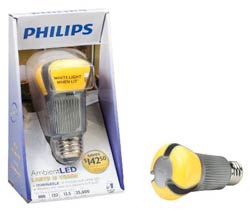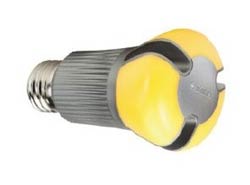Small Home Gazette, Summer 2011
The Next Big Thing in Light Bulbs?
A New Option for Lighting Your Bungalow
by Tim Counts
When household compact fluorescent lamps (CFLs) first appeared many years ago, I avoided them. The quality of light they emitted was a creepy blueish-greenish-white—I called it “light to commit suicide by.”
Fortunately, over the years CFLs have improved dramatically. While you can still buy bulbs with the colder color quality (though it bewilders me why anyone would), it’s easy to find CFLs in packages that promise “warm white light.” Though I’ve now filled most of my bungalow’s light fixtures and lamps with these “warm” CFLs, I’m not completely happy with them. Light one up next to an incandescent bulb, and a CFL still looks chillier. The light they cast on my vintage carpets and furniture makes colors look rather drab.
But I recently discovered what might be the next big thing in light bulbs: light-emitting diodes, or LEDs.
Yes, LEDs have been around for many years—their most popular use is in the newest type of Christmas light strands, which emit intensely saturated colors. But manufacturers have had difficulty coming up with an LED bulb for use in ordinary household fixtures. As the output of each diode is very small compared to incandescent or CFL lamps, you have to group a slew of them together to get the light equivalent of a 60-watt bulb—a costly production issue. And in their natural state, LEDs suffer from the same color temperature problems as CFLs. In other words, the light quality they naturally emit tends
to make one’s skin crawl.
 Recently, however, Philips Electronics (the company that in 1980 produced the first successful household CFL bulbs) has come out with LED bulbs that are a viable alternative to CFL and incandescent bulbs. Other companies have now issued competing bulbs, and more are sure to follow.
Recently, however, Philips Electronics (the company that in 1980 produced the first successful household CFL bulbs) has come out with LED bulbs that are a viable alternative to CFL and incandescent bulbs. Other companies have now issued competing bulbs, and more are sure to follow.
A bulb’s color quality, or color temperature, is measured in “kelvins,” abbreviated as K. According to a Wikipedia entry (http://en.wikipedia.org/wiki/Colour_temperature), color temperatures over 5,000 K are called cool colors (blueish white), while lower color temperatures (2,700–3,000 K) are called warm colors (yellowish white through red).
At Home Depot and Menards, you can find LED bulbs made for household use in three color temperatures.
- “Warm light.” A color temperature of 2700 K is roughly equivalent to that emitted by a classic incandescent light bulb.
- Bulbs labeled “bright white light” emit 3000 K temperature light. This quality may be acceptable for use in some areas—it doesn’t look as warm but is good for bright task lighting.
- Bulbs with a cooler color temperature emit light from 3200 K up to 5000 K or higher. Manufacturers refer to this cooler color as “daylight.” (It may technically be the color of daylight, but it just looks depressing to me.)
 I recently purchased a Philips AmbientLED 12.5 watt bulb, designed to replace a standard 60-watt household bulb, and conducted a little experiment. My bungalow’s bathroom has two light sconces, one on each side of the mirror. I’ve been using “warm” color CFLs in them for some time. I swapped one of the CFLs with the new Philips LED bulb and immediately noticed a difference. Though both bulbs were designed to emit light with a color temperature of 2700 K, the CFL’s light looked slightly greenish, while the LED’s appeared slightly pinkish. Don’t know about you, but I’d rather see my reflection (and my house) bathed in the latter light quality. (Note: If you apply makeup at your bathroom mirror, you may want to seek out special full-spectrum light bulbs—higher than 5000 K—that are recommended by cosmetics experts.)
I recently purchased a Philips AmbientLED 12.5 watt bulb, designed to replace a standard 60-watt household bulb, and conducted a little experiment. My bungalow’s bathroom has two light sconces, one on each side of the mirror. I’ve been using “warm” color CFLs in them for some time. I swapped one of the CFLs with the new Philips LED bulb and immediately noticed a difference. Though both bulbs were designed to emit light with a color temperature of 2700 K, the CFL’s light looked slightly greenish, while the LED’s appeared slightly pinkish. Don’t know about you, but I’d rather see my reflection (and my house) bathed in the latter light quality. (Note: If you apply makeup at your bathroom mirror, you may want to seek out special full-spectrum light bulbs—higher than 5000 K—that are recommended by cosmetics experts.)
The downside to the new LED bulbs? The 60-watt-equivalent bulb costs $40. Yep, you read that right: Forty dollars. Well, okay, $39.97 at Home Depot. If you can live with less light, the 40-watt-equivalent bulb is just $21.97. (Other brands are somewhat cheaper, but I haven’t tried them for light quality.)
But there are compensations. Like CFLs, LEDs last much, much longer than incandescent bulbs—the Philips package says their 60-watt-equivalent bulb will last up to 15 years. And the Philips versions of 40- and 60-wattbulb replacements are dimmable, though they require dimmer mechanisms that use the most current technology. Another nice feature of these bulbs is that they turn on at full brightness. I no longer have to flip on my bathroom light switch and wait 30 to 45 seconds for the CFLs to come up to full brightness.
The new LED bulbs may not be best for light fixtures with exposed bulbs, as the 60-watt-equivalent, in particular, is shaped like some sort of exotic, three-lobed seedpod. In addition, its surfaces are a deep yellow color. Apparently the yellow coating filters the intensely cool natural light of the LEDs inside, creating natural looking white light when lit.
Just as with CFLs, the price of LED bulbs will undoubtedly come down over time. But if you’ve got spare cash for one or two of them now, I think you’ll be pleased with the light they produce.











